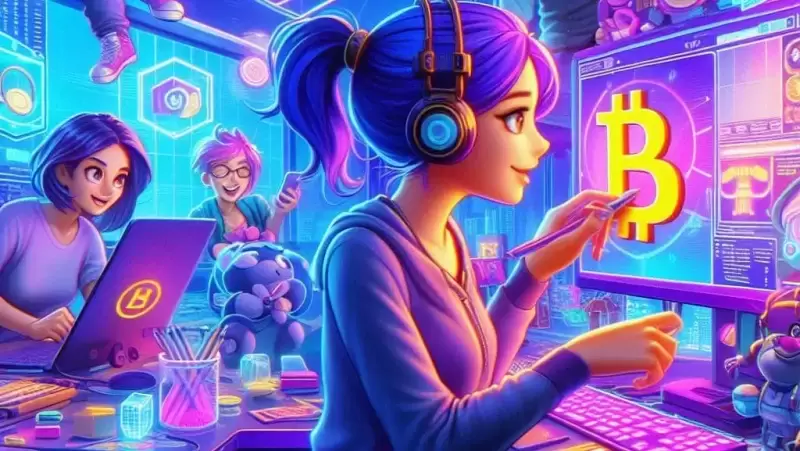 |
|
 |
|
 |
|
 |
|
 |
|
 |
|
 |
|
 |
|
 |
|
 |
|
 |
|
 |
|
 |
|
 |
|
 |
|
Cryptocurrency News Articles
The Web3 gaming model is booming, but many small creators are still struggling.
Apr 29, 2025 at 06:39 am
The gap between earnings and expectations among modders, builders, and artists on platforms like Roblox, YouTube, and Twitch is huge.

The creator economy is booming, but many small creators are still struggling. There’s a huge gap between earnings and expectations among modders, builders, and artists on platforms like Roblox, YouTube, and Twitch.
Creators are exploited through high fees, inconsistencies in the amount paid, and the steady change of platform algorithms. Luckily, we’re now seeing a new model emerge in Web3 that is focused on improving the lives of creators.
This model, which involves blockchain, NFTs, and smart contracts, is being used to build Web3 games. These games will ensure fair pay for work done, in direct contrast to the current system, where platforms take the lion’s share of earnings.
But is this a true solution, or would they see their expectation cut short?
What Is Broken In The Economy Of Creators?
Several creators lose revenue, other platforms are frantically generating billions in revenue. Several examples support this claim:
>YouTube: Only gives creators 55% of ad revenue, but this can only be achieved after they meet strict rules, like gaining enough subscribers etc.
>Twitch: Smaller platforms often end up fighting for less than half or more, making their earnings through subscriptions.
>Patreon: Most modders and developers end up without receiving anything unless they opt for donations and subscriptions.
The big platforms are making billions while creators work hard for little reward, often stuck chasing virality instead of real money. It’s like baking a cake and only getting a slice while the shop keeps the rest.
This model is also exploitative because it incentivizes creators to compete with each other for attention, leading to a "survival of the fittest" scenario where only a few creators manage to achieve significant success.
Those who do not achieve success are left with nothing but a portfolio of work that no one wants to pay for.
How Web3 Games Adjust the Conditions
It is the goal of Web3 games to alleviate these concerns by providing monetary income and control to creators through
1. NFTs for Creators
Games like The Sandbox allow users to:
* Easily create content like maps, skins, or mods
* Mint this content into NFTs
* Place these NFTs in the game world for others to use
* Earn royalties every time someone else sells or integrates their NFT creations
Especially considering that:
>Example: In 2024, The Sandbox saw 17 million visits during its Alpha Season 3, and creators profited from user-generated content.
>300 million people interacted with user-generated content within Sandbox and 7.5 million unique wallets.
2. Royalty Via Smart Contracts
Every player in Shrapnel (a Web3 FPS game) can design maps or skins, mint them into NFTs and receive royalties perpetually every time they are utilised or exchanged.
Just imagine, for the first time, Skyrim modders get compensated every time someone uses their mod, without any begging needed.
3. Community Awards and Tokens
For example, Decentraland usually pays its users MANA tokens for the creation of content and for hosting events. In addition, these tokens:
* Can be sold for cryptocurrency on exchanges like Binance.
* Are used to pay for goods and services within Decentraland's ecosystem.
Additional Layer: Creators Meridian and other DAOs allow the community to vote for who will be rewarded, therefore, allowing creators to be compensated by their benefactors who gain value reaped from these efforts.
4. Player-Supported Earnings
Splinterlands allows Web3 gaming streamers to run tournaments with prize pools funded by players, not companies. The Sandbox’s Game Maker Fund paid 20 Web3 gaming creators in 2024. Web3 gaming removes the platform’s big fees, letting creators keep more money.
This model helps creators earn from their efforts, not from pleasing platforms.
Challenges to Overcome
Web3 gaming looks promising, but it is not perfect yet. To get started is a bit tricky; to set up a digital wallet feels like learning a new tool with too many steps. Fees on some digital money networks can reduce earnings, though cheaper options like Polygon are improving. Scams are a serious issue here also. For example, in 2024, many Web3 gaming creators lost money to fake projects that disappeared with their investments. Also, the coins earned can lose value quickly, like a stock dropping, which makes payouts uncertain
The Evolution of the Creator Economy
Web3 games are not attempting to mend the system; rather, they are constructing a new one. This is their significance:
* They introduce a more equitable and transparent approach to content creation and monetization.
* They are also pushing the boundaries of what is possible with blockchain technology.
Concluding Remarks
Web3 games may not be fully optimised yet, but they’re certainly trying to steer the creator economy in the right direction. More creators will seek out these new technologies, especially when the infrastructure becomes readily available and regulations become more favourable
Disclaimer:info@kdj.com
The information provided is not trading advice. kdj.com does not assume any responsibility for any investments made based on the information provided in this article. Cryptocurrencies are highly volatile and it is highly recommended that you invest with caution after thorough research!
If you believe that the content used on this website infringes your copyright, please contact us immediately (info@kdj.com) and we will delete it promptly.
-

-

-

-

-

- Coinbase CEO Urges Companies to Dive into Crypto's Explosive Growth
- Apr 29, 2025 at 04:10 pm
- Brian Armstrong, CEO of crypto exchange Coinbase (Nasdaq: COIN), responded Monday on social media platform X to commentary crediting Coinbase with steering the cryptocurrency industry through difficult regulatory challenges.
-

- Bitcoin blew up over 94,000 US dollars on April 23 and for the first time in a month in a month was given the combined value of all digital coins over three trillion dollars.
- Apr 29, 2025 at 04:10 pm
- The record movement was limited as a recovery Vontrong April. Four weeks ago, Bitcoin had difficulty staying over one -time dollar.
-

-

- Messika, the Parisian fine jewelry brand, now accepts cryptocurrency payments across its boutiques and online store, embracing bitcoin, ether, USDT, and solana through a seamless integration with Lunu.
- Apr 29, 2025 at 04:05 pm
- Paris-based fine jewelry house Messika has taken a major step into the future of luxury retail, announcing it now accepts cryptocurrency payments
-

- Kim Byung-hyun and Shin Hyun-joon brought laughter as they performed as "Dumb and Dumber Nolbuz."
- Apr 29, 2025 at 04:00 pm
- On the 28th (Monday) episode of KBS2's entertainment show "Study and Play," a total of seven family teams participated in a quiz, featuring intergenerational MCs Kang Ho-dong, Kim Ho-young, and Lee Soo-yeon, starting with Kim Jung-tae and his son Kim Si-hyeon (6th grade), followed by Kahi and her sons Yang Noah (3rd grade) & Yang Si-on (1st grade), Yang Eun-ji and her daughter Lee Ji-eum (2nd grade), Kim Byung-hyun and his sons Kim Tae-yoon (5th grade) & Kim Joo-sung (2nd grade), Shin Hyun-joon and his son Shin Ye-jun (1st grade), Lee Ji-hoon and his sons Lee Ho-jun (4th grade) & Lee Seo-jun (1st grade), and finally Lee Yoo-jun and his son Lee Joong-hyeon (2nd grade).



























































